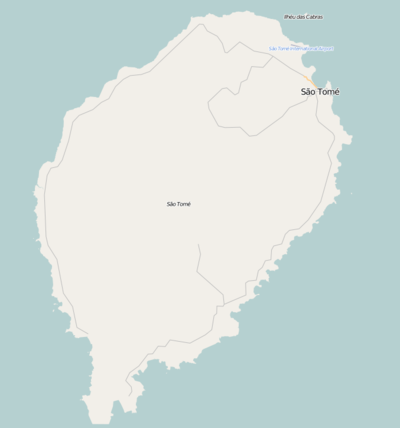Bombaim
| Bombaim | |
|---|---|
| Village | |
.jpg) Roça Bombaim | |
 Bombaim Location on São Tomé Island | |
| Coordinates: 0°14′58″N 6°38′55″E / 0.24944°N 6.64861°ECoordinates: 0°14′58″N 6°38′55″E / 0.24944°N 6.64861°E | |
| Country |
|
| Province | São Tomé Province |
| District | Mé-Zóchi |
| Time zone | UTC+0 (UTC) |
Bombaim is a small village on São Tomé Island in São Tomé and Príncipe. Its population is 34 (2008 est.).[1] Nearby settlements includes Vale Formoso and São Januário. Bombaim are one of the highest settlements in the country with its elevation around 500 meters above sea level, it has a remote road and a hiking trail linking with the island's and nation's tallest summit, Pico de São Tomé. Caué District's boundary is nearby in the southwest and the rest is close to Cantagalo District.
Population history
| Historical population | ||
|---|---|---|
| Year | Pop. | ±% |
| 2001 (census) | 30 | — |
| 2008 (estimate) | 34 | +13.3% |
Description
Bombaim is the Portuguese name for "Mumbai" (until 2001 as Bombay) which is today India's largest city. The etymology is named after its nearby stream Água Bomba in which the river flows and has no relation to the Portuguese name of the city in India. The stream name's etymology is not named after the bombs, but the name bomba which is of Angolan origin.
As there is a village named Bombom, there is no relation to the spelling as the spelling and its etymology is different, also being located in the same district, that village is located in the east end.
The settlement is just around a kilometer east of Obo Natural Park. Wildlife remains to be abundant throughout the area today such as the bird species of the São Tomé olive pigeon and the São Tomé fiscal,[2][3] both are endangered. In recent years, some of the rare animals were partly endangered. Species first discovered around Bombaim includes Apospasta tamsi, Theretra viridis, Zamarada tomensis and Hyalobathra barnsalis (Isocentris barnsalis). In nearby Macambrara area, there is a species of moths known as Acraea severina with its subspecies severina
Also a landmark named Roça de Bombaim is located in the village which serves as a hotel today. Another nearby landmark, less common is Roça de Tras os Montes.
Notes
- ↑ INE, Evolução da população São-Tomense por localidades, 2001/2007-08
- ↑ BirdLife International (2012). "Lanius newtoni". IUCN Red List of Threatened Species. Version 2013.2. International Union for Conservation of Nature. Retrieved 26 November 2013.
- ↑ "African Bird Club | Working for birds in Africa – São Tomé e Príncipe". africanbirdclub.org. Retrieved 23 February 2017.
Further reading
External links
- Roça Bombaim - As Roças de São Tomé
- Map of the archipelago of São Tomé and Príncipe.
- São Tomé and Príncipe.
- worldatlas São Toméand Príncipe.
- Homepage of the Government of the Democratic Republic of São Tomé and Príncipe.
- "São Tomé". sao-tome.com. Retrieved 18 February 2017.
